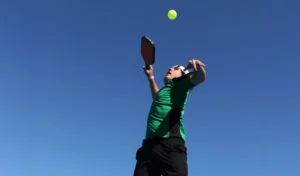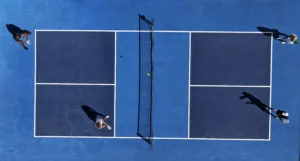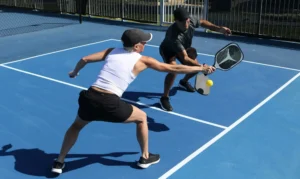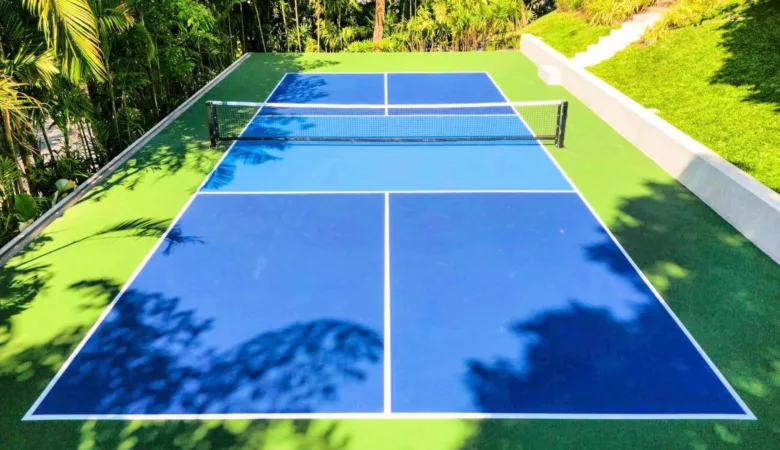
Whether you’re an amateur or an experienced player, learning about pickleball court dimensions will help you to enhance your gameplay. In this detailed guide, we will discuss the dimensions and markings of a pickleball court so you can move about it confidently and easily.
Pickleball Court Dimensions
A pickleball court is relatively close compared to a badminton court, thus slightly smaller than an ordinary tennis court. These are the principal dimensions you should take note of:
- Court Size: A typical pickleball court measures 20 by 44 feet, whether one is playing single or double games.
- Net Height: The net stands 36 inches at the sidelines and 34 inches in the middle. The lower middle invites players to shoot strategically.
- Non-Volley Zone (The Kitchen): The non-volley zone, also called the “kitchen,” is a 7-foot region on each side of the net where players are not allowed to volley the ball.
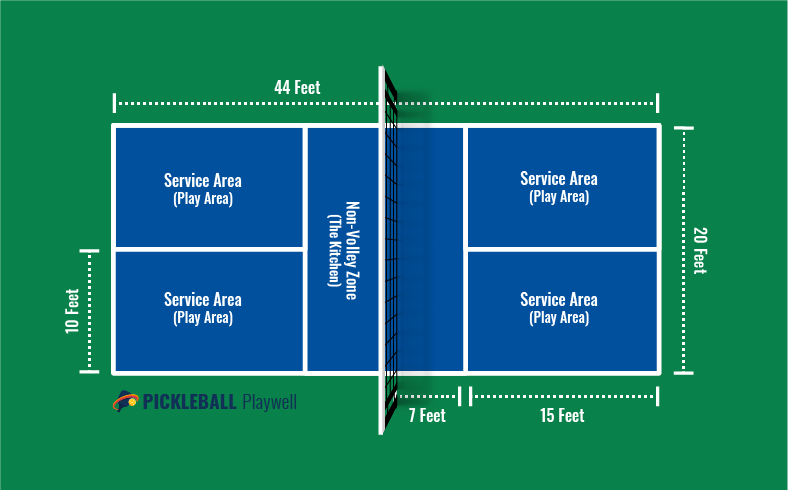
These measurements allow people of all ages and skill levels to play and enjoy this game. It also allows for more straightforward court coverage, such as in tennis, without the blistering sprints involved.
Pickleball Court Markings Explained
To play pickleball effectively, you must comprehend the most essential court markings and how they affect the game. These lines set boundaries, prescribe gameplay rules, and impact strategy; thus, they must be known to all players.
- Baselines: These are the back boundary lines of the court, running parallel to the net. When serving, at least one foot must be behind the baseline until after you make contact with the ball.
- Sidelines: These lines run perpendicular to the net, define the court’s width, and help determine whether a ball is in or out during play.
- Non-Volley Zone Line (Kitchen Line): This line indicates the 7-foot non-volley zone on both net sides. Players cannot volley (hit the ball out of the air) while standing in this zone.
- Centerline: This line separates the service courts into left and right halves. It’s employed to identify the appropriate area for service.
- Service Court: The court is split into four service boxes (two on each side of the net). A valid serve must land diagonally in the opposite service box.
Mastering these court markings will help you play smarter, avoid faults, and improve your overall strategy on the court!

The Kitchen: The Essentials
The kitchen (also known as the Non-Volley Zone) is one of a pickleball court’s most unique and strategic areas. It’s a 7-foot zone on either side of the net, and knowing how to navigate it correctly is crucial to mastering the game. The kitchen is perhaps the most iconic aspect of a pickleball court and there are a few key pickleball rules regarding it:
Key Kitchen Rules:
- No Volleys Allowed: Players cannot volley (hit the ball out of the air) while standing in the kitchen or touching the kitchen line. Doing so results in a fault.
- Entering the Kitchen: You can step into the kitchen to hit a ball only if it has bounced first, but you should step out afterward to avoid getting caught in a vulnerable position.
- Staying Too Long – Lingering in the kitchen without reason isn’t technically illegal, but it’s risky—you might be forced into a weak position or commit a fault if a volley opportunity arises.
The kitchen’s purpose is to prevent aggressive net smashes, encouraging longer rallies and more strategic play. Mastering when to enter and exit the kitchen is a key skill in pickleball!
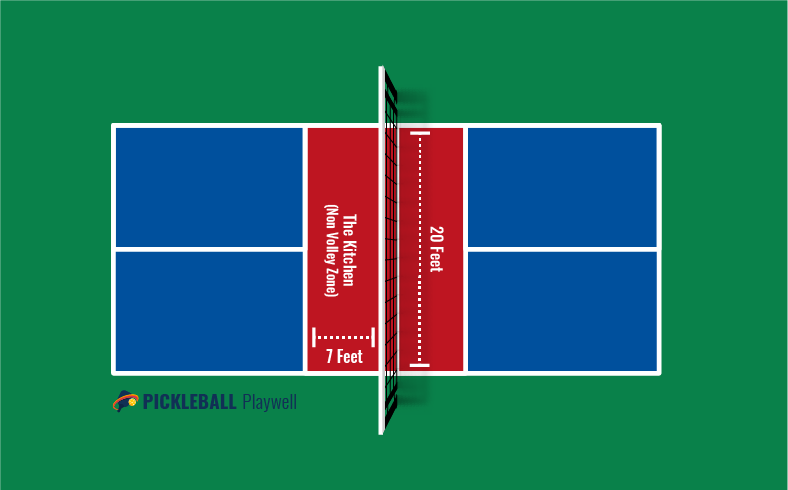
Kitchen Rules Summary
| Rule | Description |
|---|---|
| No Volleys Allowed | Players cannot volley while standing in the kitchen or touching the kitchen line. |
| Entering the Kitchen | Allowed only to hit a bounced ball; players must exit immediately afterward. |
Net Placement and Height in Pickleball Court
The net separates the court into two halves and has certain height specifications:
- Height at Sidelines: The net must be 36 inches high at the sidelines.
- Height at Center: At the center, the net must be 34 inches high.

The net is positioned slightly lower in the middle to introduce a strategic aspect to the game so that players target this section not to hit the ball too hard and present opponents with an effortless volley.
Service Zones and Positioning on Court

While serving, the court is demarcated into varying service zones responsible for deciding the correct positioning:
- Right and Left Service Courts: The server has to serve diagonally to the opponent’s service court. Right-hand side serving is done when the server has an even score, and left-hand side serving is done with an odd score.
- Baseline Positioning: The server must remain at least one foot behind the baseline during serving. This ensures that serves are made from the correct position and do not invade the court.
Knowing which service court to serve from is important in doubles. This helps ensure that the game goes smoothly and that players comply with server order and positioning rules.
Understanding In and Out In Pickleball
The sidelines and baselines are used to determine whether a shot is in or out:
- Sidelines: Balls landing on the sidelines are considered in. Any shot that lands outside these lines is out.
- Baselines: Similarly, shots landing on the baseline are in, while those beyond it are out.
- Kitchen Line: For serves, the ball must clear the kitchen line to be considered valid. If the serve lands in the kitchen, it results in a fault.
The lines are an essential part of the game, and learning to aim for them can help you make difficult strategic shots for your opponents to return.
FAQs About Pickleball Court Layout
What are the regulation dimensions of a pickleball court?
A regulation pickleball court measures 44 feet in length and 20 feet in width, which applies to both singles and doubles play.
Here’s a breakdown of the key court dimensions:
- Total Court Size – 44 feet long × 20 feet wide
- Non-Volley Zone (Kitchen) – Extends 7 feet from the net on both sides
- Service Courts – Each service box is 10 feet wide and divided by the centerline
- Net Height – 36 inches at the posts and 34 inches in the middle
These dimensions make pickleball courts smaller than tennis courts, allowing for faster gameplay, quick reactions, and strategic shot placement.
Why the Kitchen is Important in Pickleball?
It discourages players from overpowering at the net with aggressive smashes, thus forcing them to rely on clever placement and strategic selection of shots instead of pure reflexes.
Key Reasons the Kitchen Matters:
- Prevents Net Domination – Players cannot volley (hit the ball in the air) while standing in the kitchen, making it harder to overpower opponents with quick smashes.
- Encourages Strategic Play – Instead of rushing the net, players must use dinks, soft shots, and well-placed returns to outmaneuver their opponents.
- Creates Longer Rallies – The kitchen ensures that pickleball remains a game of patience and positioning rather than just speed and power.
Mastering the art of kitchen play—knowing when to step in for a bounced shot and when to stay back—is key to improving your pickleball game!
Am I permitted to step the service line through after hitting a volley?
No, stepping on or over the kitchen line (non-volley zone line) while hitting a volley is a fault in pickleball. The rules state that:
- You cannot volley the ball (hit it out of the air) while stepping on or into the kitchen—even if your momentum carries you forward after the shot.
- However, you can step into the kitchen to hit a ball only if it has bounced first.
This rule prevents players from crowding the net and smashing volleys at close range, ensuring a more strategic and fair game. Always stay behind the kitchen line when volleying to avoid faults!
How high is the pickleball net?
The pickleball net height is:
- 36 inches (3 feet) at the sidelines
- 34 inches (2 feet 10 inches) in the center
This slight dip in the middle adds an extra layer of strategy, as hitting shots low over the net in the center gives you the best chance of keeping the ball in play while making it harder for opponents to attack.
Mastering shot placement at different net heights can give you a competitive edge in your game!
How do I decide from which service court to serve?
It’s simple—just check your score!
- If your score is even (0, 2, 4, 6, etc.), serve from the right-hand side of the court.
- If your score is odd (1, 3, 5, 7, etc.), serve from the left-hand side of the court.
This rule ensures a consistent rotation and helps maintain order in singles and doubles play. Just remember: Even = Right, Odd = Left, and you’ll always be in the correct serving position!
Mastering the Court
To improve your pickleball game, you must start with a good knowledge of the court. Knowing where the kitchen, baselines, and service boxes are is not just about following rules; it is about playing smarter and feeling comfortable with your movement. Good court awareness is a big plus when serving, volleying, or ready to return.
The second time you step onto the court, it will be a good idea to devote a minute to the lines and markings, as it will make a significant difference in your game. The more you know the space around you, the more refined your plan and reaction will be. So, take your paddle, confidently step into the court, and take charge of your game.
